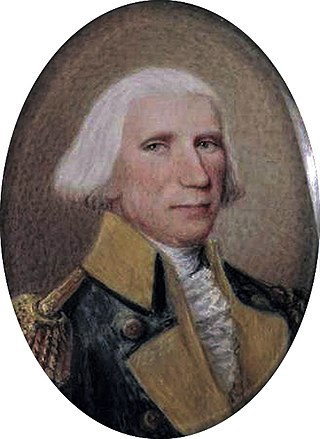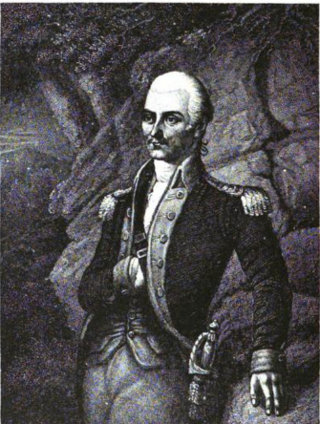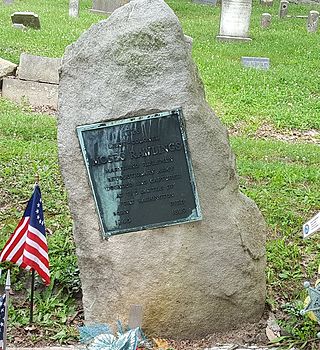
Henry Dearborn was an American military officer and politician. In the Revolutionary War, he served under Benedict Arnold in his expedition to Quebec, of which his journal provides an important record. After being captured and exchanged, he served in George Washington's Continental Army. He was present at the British surrender at Yorktown. Dearborn served on General George Washington's staff in Virginia.

Jonathan Dayton was an American Founding Father and politician from the U.S. state of New Jersey. At age 26 he was the youngest person to sign the Constitution of the United States. He was elected to the United States House of Representatives in 1791 and later served from 1795-1799 as its third Speaker. He left the House in 1799 after being elected to the U.S. Senate, where he served one term. Dayton was arrested in 1807 for alleged treason in connection with Aaron Burr's conspiracy to establish an independent country in the Southwestern United States and parts of Mexico. He was exonerated by a grand jury and never tried, but his national political career never recovered.

Tench Tilghman was an officer in the Continental Army during the American Revolutionary War. He served as an aide-de-camp to General George Washington, achieving the rank of lieutenant colonel.

Elias Dayton was an American merchant and military officer who served as captain and colonel of the local militia and in 1783 rose to become a brigadier general during the American Revolutionary War. Afterward, he became the Mayor of Elizabethtown, New Jersey as well as served in the New Jersey General Assembly. He was the father of U.S. Constitution signer Jonathan Dayton.

Henry Burbeck was a senior officer of the United States Army who served as the Commandant of the Corps of Artillerists and Engineers from 1798 to 1802.

Aaron Ogden was an American soldier, lawyer, United States Senator and the fifth governor of New Jersey. Ogden is perhaps best known today as the complainant in Gibbons v. Ogden which destroyed the monopoly power of steamboats on the Hudson River in 1824.

The 2nd Canadian Regiment (1776–1783), also known as Congress' Own or Hazen's Regiment, was authorized on January 20, 1776, as an Extra Continental regiment and raised in the province of Quebec for service with the American Continental Army under the command of Colonel Moses Hazen. All or part of the regiment saw action at Staten Island, Brandywine, Germantown and the Siege of Yorktown. Most of its non-combat time was spent in and around New York City as part of the forces monitoring the British forces occupying that city. The regiment was disbanded on November 15, 1783, at West Point, New York.

Shepard Kollock, Jr. was an editor and printer, who was active in colonial New Jersey during the period of the American Revolutionary War. He also held various government positions in the newly founded state of New Jersey during the early 1800s.
James Francis Armstrong was a chaplain from New Jersey in the American Revolutionary War and a Presbyterian minister for 30 years in Trenton, New Jersey.

General Henry Champion was born to Colonel Henry Champion and Deborah Brainard. He was a descendant of the Henry Champion who settled in Connecticut in 1647. He sailed to the colony from Norwich, England.

Associators were members of 17th- and 18th-century volunteer military associations in the British American thirteen colonies and British Colony of Canada. These were more commonly known as Maryland Protestant, Pennsylvania, and American Patriot and British Loyalist colonial militias. But unlike militias, the associator military volunteers were exempt from regular mandatory military service. Other names used to describe associators were "Associations", "Associated", "Refugees", "Volunteers", and "Partisans".

Robert Troup was a soldier in the Continental Army during the American Revolutionary War and a United States district judge of the United States District Court for the District of New York. He participated in the Battles of Saratoga and was present at the surrender of British General John Burgoyne.

Francis Barber (1750–1783) was a colonel in the Continental Army during the American Revolutionary War. He was in the Sullivan Expedition and at the Siege of Yorktown with the 3rd New Jersey Regiment. He was wounded at the Battle of Monmouth and again at the Battle of Newton. He was killed in New Windsor, New York, where the army was camped in 1783, when a tree that was being cut fell on him as he was riding his horse to dine with George Washington in Newburgh, New York.
Events from the year 1783 in the United States. The American Revolution officially ended with the Treaty of Paris.

Moses Rawlings (1745–1809) served in the Continental Army during the American Revolutionary War, most notably at the Battle of Fort Washington. He attained the rank of lieutenant colonel before leaving the military in 1779. He later served as the State Commissioner for Prisoners in Maryland.
Colonel Samuel Ogden was a colonial businessman in New Jersey who had an iron works. He fought on the winning side during the American Revolutionary War. Afterward, he became a developer and land speculator for a large tract of land in upstate New York.

Oliver Spencer was a New Jersey officer during the American Revolutionary War and received a special commission to enlist and lead one of 16 Additional Continental Regiments. He was born in Connecticut and later moved to New Jersey, where he married Anna Ogden and became a tanner. He joined the revolutionary cause and engaged a British force in December 1776 as a major of New Jersey militia. On 15 January 1777 during the Forage War, his militiamen captured 70 German mercenaries. That month George Washington authorized him to recruit Spencer's Additional Continental Regiment. As colonel, he led this unit at Brandywine and Germantown in 1777 and Monmouth in 1778. His regiment participated in the Sullivan Expedition in 1779 and was disbanded at the beginning of 1781. The conflict having ruined his home and his tanning business, he moved to Ohio, where he served as a probate judge and militia commander. He was the nephew of General Joseph Spencer.

The Death of General Montgomery in the Attack on Quebec, December 31, 1775 is an oil painting completed in 1786 by the American artist John Trumbull. It depicts American general Richard Montgomery at the Battle of Quebec during the invasion of Quebec. The painting is on view at the Yale University Art Gallery in New Haven, Connecticut. It is the second in Trumbull's series of national historical paintings on the American Revolutionary War, the first being The Death of General Warren at the Battle of Bunker's Hill, June 17, 1775.
Lt. Abijah Hammond, Jr was an American artillery officer in the Revolutionary War in the Continental line. After the war, he became a merchant and real estate investor active in various endeavors important to the development of New York.
















